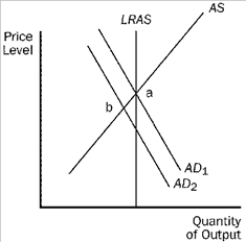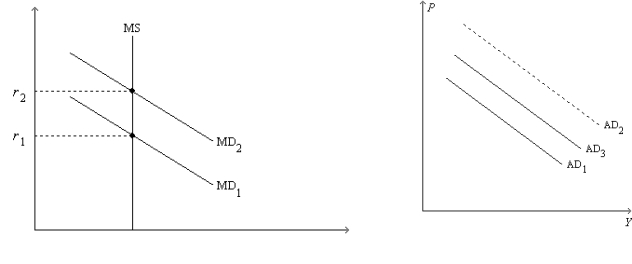A) the short run but not in the long run.
B) the long run but not in the short run.
C) both the short and long run.
D) neither the short nor long run.
Correct Answer

verified
Correct Answer
verified
Multiple Choice
The theory of liquidity preference illustrates the principle that
A) monetary policy can be described either in terms of the money supply or in terms of the interest rate.
B) monetary policy can be described either in terms of the exchange rate or the interest rate.
C) monetary policy must be described in terms of the money supply.
D) monetary policy must be described in terms of the interest rate.
Correct Answer

verified
Correct Answer
verified
Multiple Choice
For the following questions, use the diagram below:
Figure 34-7  -Refer to Figure 34-7. If the economy is at point b, a policy to restore full employment would be
-Refer to Figure 34-7. If the economy is at point b, a policy to restore full employment would be
A) an increase in the money supply.
B) a decrease in government purchases.
C) an increase in taxes.
D) All of the above are correct.
Correct Answer

verified
Correct Answer
verified
Multiple Choice
Scenario 34-1. Take the following information as given for a small, imaginary economy: -When income is $10,000, consumption spending is $6,500. -When income is $11,000, consumption spending is $7,250. -Refer to Scenario 34-1. For this economy, an initial increase of $200 in net exports translates into a(n)
A) $570 increase in aggregate demand when the crowding-out effect is taken into account.
B) $800 increase in aggregate demand when the crowding-out effect is taken into account.
C) $1,400 increase in aggregate demand in the absence of the crowding-out effect.
D) $800 increase in aggregate demand in the absence of the crowding-out effect.
Correct Answer

verified
Correct Answer
verified
Multiple Choice
During recessions, automatic stabilizers tend to make the government's budget
A) move toward deficit.
B) move toward surplus.
C) move toward balance.
D) not necessarily move the budget in any particular direction.
Correct Answer

verified
Correct Answer
verified
Multiple Choice
Other things equal, in the short run a lower price level leads households to
A) increase consumption and firms to buy more capital goods.
B) increase consumption and firms to buy fewer capital goods.
C) decrease consumption and firms to buy more capital goods.
D) decrease consumption and firms to buy fewer capital goods.
Correct Answer

verified
Correct Answer
verified
Multiple Choice
"Monetary policy can be described either in terms of the money supply or in terms of the interest rate." This statement amounts to the assertion that
A) shifts of the money-supply curve cannot occur if the Federal Reserve decides to target an interest rate.
B) the aggregate-demand curve will not shift in response to Federal Reserve actions if the Fed decides to target an interest rate.
C) changes in monetary policy aimed at contracting aggregate demand can be described either as decreasing the money supply or as raising the interest rate.
D) the activities of the Federal Reserve's bond traders are irrelevant if the Federal Reserve decides to target an interest rate.
Correct Answer

verified
Correct Answer
verified
Multiple Choice
Figure 34-6. On the left-hand graph, MS represents the supply of money and MD represents the demand for money; on the right-hand graph, AD represents aggregate demand. The usual quantities are measured along the axes of both graphs.  -Refer to Figure 34-6. Suppose the graphs are drawn to show the effects of an increase in government purchases. If it were not for the increase in r from r1 to r2, then
-Refer to Figure 34-6. Suppose the graphs are drawn to show the effects of an increase in government purchases. If it were not for the increase in r from r1 to r2, then
A) there would be no crowding out.
B) the full multiplier effect of the increase in government purchases would be realized.
C) the AD curves that actually apply, before and after the change in government purchases, would be separated horizontally by the distance equal to the multiplier times the change in government purchases.
D) All of the above are correct.
Correct Answer

verified
Correct Answer
verified
Multiple Choice
Initially, the economy is in long-run equilibrium. Aggregate demand then shifts leftward by $50 billion. The government wants to increase its spending in order to avoid a recession. If the crowding-out effect is always one- third as strong as the multiplier effect, and if the MPC equals 0.6, then by how much do government purchases have to increase in order to offset the $50 billion leftward shift?
A) by $90 billion
B) by $60 billion
C) by $20 billion
D) by $30 billion
Correct Answer

verified
Correct Answer
verified
Short Answer
Last year, total income increased $1,000 and consumption increased $800. An increase in government spending equal to $10 would cause output to increase by $_____ because the multiplier is ______.
Correct Answer

verified
Correct Answer
verified
Multiple Choice
Critics of stabilization policy argue that
A) policy affects aggregate demand quickly, but the effects on aggregate demand are long-lived.
B) policy affects aggregate demand with a lag, and the effects on aggregate demand are long-lived.
C) policy affects aggregate demand with a lag, but the effects are short-lived.
D) policy does not affect aggregate demand.
Correct Answer

verified
Correct Answer
verified
Multiple Choice
There is an increase in government expenditures financed by taxes and its overall short-run effect on output is larger than the change in government spending. Which of the following is correct?
A) By themselves, both the change in output and the change in the interest rate increase desired investment.
B) By themselves, both the change in output and the change in the interest rate decrease desired investment.
C) By itself, the change in output increases desired investment spending and by itself the change in the interest rate decreases desired investment spending.
D) By itself, the change in output decreases desired investment spending and by itself the change in the interest rate increases desired investment spending.
Correct Answer

verified
Correct Answer
verified
True/False
The theory of liquidity preference is largely at odds with the basic ideas of supply and demand.
Correct Answer

verified
Correct Answer
verified
Multiple Choice
The Fed can influence the money supply by
A) changing how much it lends to banks.
B) changing the interest rate it pays banks on the reserves they are holding.
C) using open-market operations.
D) All of the above are correct.
Correct Answer

verified
Correct Answer
verified
Multiple Choice
If the Federal Reserve increases the money supply, then initially there is a
A) shortage in the money market, so people will want to sell bonds.
B) shortage in the money market, so people will want to buy bonds.
C) surplus in the money market, so people will want to sell bonds.
D) surplus in the money market, so people will want to buy bonds.
Correct Answer

verified
Correct Answer
verified
True/False
Other things equal, the higher the price level, the higher is the real wealth of households.
Correct Answer

verified
Correct Answer
verified
Multiple Choice
If the Fed conducts open-market purchases, then which of the following quantities increase(s) ?
A) interest rates and investment spending
B) interest rates, but not investment spending
C) investment spending, but not interest rates
D) neither interest rates nor investment spending
Correct Answer

verified
Correct Answer
verified
Multiple Choice
Which of the following events would shift money demand to the left?
A) an increase in the interest rate or an increase in the price level
B) an increase in the interest rate, but not an increase in the price level
C) an increase in the price level, but not an increase in the interest rate
D) neither an increase in the interest rate nor an increase in the price level
Correct Answer

verified
Correct Answer
verified
Multiple Choice
Which of the following sequences best explains the negative slope of the aggregate-demand curve?
A) price level ↑ ⇒ demand for money ↑ ⇒ equilibrium interest rate ↑ ⇒ quantity of goods and services demanded ↓
B) price level ↑ ⇒ demand for money ↓ ⇒ equilibrium interest rate ↑ ⇒ quantity of goods and services demanded ↓
C) price level ↓ ⇒ demand for money ↓ ⇒ equilibrium interest rate ↑ ⇒ quantity of goods and services demanded ↓
D) price level ↑ ⇒ equilibrium interest rate ↑ ⇒ demand for money ↑ ⇒ quantity of goods and services demanded ↓
Correct Answer

verified
Correct Answer
verified
Multiple Choice
Some economists argue that
A) monetary policy should actively be used to stabilize the economy.
B) fiscal policy should actively be used to stabilize the economy.
C) fiscal policy can be used to shift the AD curve.
D) All of the above are correct.
Correct Answer

verified
Correct Answer
verified
Showing 361 - 380 of 508
Related Exams